
Ben Sakoguchi, Chinatown, 2014. Acrylic on canvas, 15 panels, 53 × 91 in. overall. Courtesy of the artist and Bel Ami, Los Angeles. Photo: Paul Salveson.
I was thinking about Michel de Certeau while standing in front of Ben Sakoguchi’s Chinatown (2014), a multi-panel painting addressing a nineteenth-century massacre of Chinese American residents of Los Angeles. The painting, which I will describe in greater detail below, was the centerpiece of an exhibition of the artist’s work at Bel Ami gallery (uncoincidentally located in Los Angeles’s current “official” Chinatown). Sakoguchi, like de Certeau, has a knack for accumulating and condensing historical effluvia, personal stories, and social observations, and Chinatown is one of the most complex manifestations of this approach in more than six decades of making. De Certeau is best known for The Practice of Everyday Life (1980), but his first book, The Possession at Loudun, was the text I was mulling. Written in French in 1970 and translated into English thirty years later, it concerns a spate of demonic possessions in a seventeenth century Ursuline convent in Loudun, an otherwise sleepy commune in northwest France.
These events from centuries ago, which resulted in the torture and burning at the stake of Urbain Grandier, the local parish priest, produced a fair amount of interpretive ephemera at the time they occurred. Tourists (or were they religious pilgrims?) travelled to confirm the sometimes pulpy accounts of the possessions and exorcisms that were passed around in more populous places. Some of the primary participants, like the Prioress Jeanne des Anges, who was at one point possessed by seven demons, and Jean-Joseph Surin, a Jesuit exorcist and mystic whose pious attempts at remediation convinced those same demons to take up habitation in his own body, driving him almost to the point of suicide, became minor celebrities. Broadsheets, letters, and a litany of other sources concerning these events were published and circulated, like rumors dressed in the habit of fact, with one claim asserted over the other. “The dead man prompts speech, but in discordant voices,” de Certeau wanly notes, perhaps self-reflexively throwing his own efforts in with the lot. To be sure, the possessions continued to produce a cacophonous literature into the twentieth century, including serving as the subject of Aldous Huxley’s novel The Devils of Loudun (1952) and Ken Russell’s cult film The Devils (1971). Huxley, who was writing at a moment when McCarthyism raged, positioned the possessions as a remarkable and historical instance of media manipulation and groupthink, whereas Russell’s lusty drama takes a different line, casting Vanessa Redgrave and Oliver Reed as anointed antagonists in a more abstract and nearly chthonic tug-of-war between propriety and chaos. (This symbolic conflict finds visual form in the heft of the production’s design, provided by a young theater designer and experimental filmmaker named Derek Jarman.)1
In de Certeau’s unique approach to the possessions at Loudun, he performs the role of a cultural amanuensis, gathering together and quoting at length (occasionally in entirety) a heterogeneous array of archival documents left in the wake of the possessions. Instead of offering a singular interpretation—one in which the possessions might be explained away as a spiritual, medical, or psychologically significant yet anomalous event—his interjections and Talmudic commentary function instead as loose connective tissue that reveals the conditions and processes under which certain interpretations are made possible. This allows him to make bigger claims, for example that the possessions are not simply an isolated or eccentric case of religious intensification but rather a “drama of a perturbation in knowledge,” an epistemic break in the way the world might be experienced and understood henceforth.2 In this task de Certeau believed himself to be writing in the “interspace” of historical exegesis, a zone between a collective sense of history and its extant archives.
“The historian himself would be fooling himself,” de Certeau writes, “if he believed he was rid of that strangeness internal to history by placing it somewhere on the outside, far from us, in a past closed with the last ‘aberrations’ of yesteryear, as if ‘possession’ were over with the possession at Loudun.”3 He continues: “Bound to a historical moment—that is, to the passage from religious criteria to political ones, from a cosmological and celestial anthropology to a scientific organization of natural objects ordered by the scrutiny of man—the possession of Loudun opens out also onto the strangeness of history, the reflexes triggered by its alterations, and the question that arises the moment there loom before us—different from the deviltries of former times but no less troubling—the new social figures of the other.”4
Over the course of his career, de Certeau became more attuned to the “social figures of the other,” in part by revisiting his work on the Loudun possessions and noticing anew the fundamental difference by which religious authorities and the incipient medical professions approached the possessed nuns. While the exorcist required the possessing demon to answer the question “Who is there?” a doctor might begin with the somatic symptoms of the patient and ask, “What is it?”5 Both doctor and priest reject the approach of the other, yet they are fundamentally united in the dismissal of the sensate and embodied knowledge of the patient/possessed. The doctor obliterates her subjectivity by approaching her as a fleshy sack in and on which symptoms manifest, and the exorcising priest demands she shrink into oblivion so that a demonic entity might emerge and ultimately name itself. In de Certeau’s words, “The voice of the unconscious possessed woman and the body of the mute patient are there only in order to assent to the knowledge that alone is speaking.” 6
As with many of the retellings of the possessions at Loudun, Sakoguchi’s historical précis does not feel remote or anodyne. Instead, it is hot and close, accusatory and tough. Chinatown’s dizzy oscillation between revulsion and seduction is indicative of the velocity and force of stereotypical, racist representations in popular culture and the concomitant historical amnesia regarding the brutality visited upon Asian people. It was impossible, for example, given the force and topic of Sakoguchi’s painting, not to turn inward to reflect upon the mass execution that had only recently occurred at the Aromatherapy Spa and Gold Spa in Atlanta and Young’s Asian Massage in Acworth, Georgia, where the majority of those who perished were Asian American women.
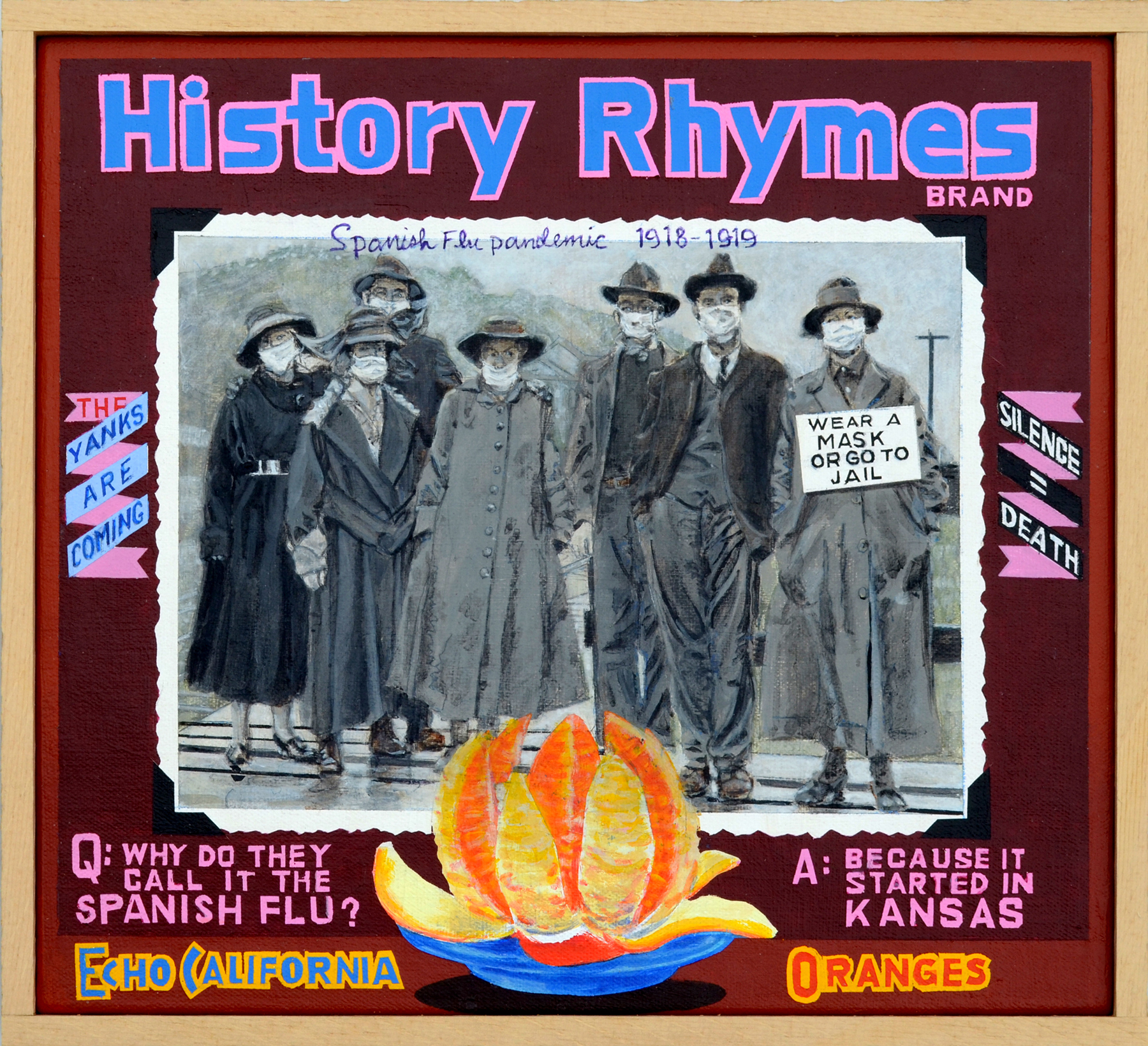
Ben Sakoguchi, History Rhymes Brand, 2020. Acrylic on canvas, 10 × 11 in. Courtesy of the artist and Bel Ami, Los Angeles.
In addition to Chinatown, the exhibition featured a small but potent survey of Sakoguchi’s most well-known series, the Orange Crate Label paintings (1974— ongoing). Diverse in the subjects they address, but consistent in format and iconography, these 10-by-11-inch canvases have formal characteristics inspired by the brightly hued and once-ubiquitous lithographs that adorned the sides of nineteenth- and early twentieth-century produce crates. As a kid growing up in San Bernardino, where the Orange Show was a major annual festival, Sakoguchi was familiar with both the spectacle and the prosaism of California’s citrus industry; he has spoken of the orange crates he encountered in the back of his family’s grocery business as being a kind of informal art education.7 His Orange Crate Label paintings always include three elements: an artist-invented brand name, a depiction of an orange (wrapped, sliced, peeled, or otherwise), and a California place name.
Some of the show’s most recent Orange Crate Label works were made during the first months of the COVID-19 pandemic, and one of these, dedicated to an invented History Rhymes brand of oranges from Echo, California, is a dense summation of Sakoguchi’s working method. The painting depicts an appropriated black-and-white photographic image (spot the trompe l’oeil black mounting corners) focused on a group of people standing together, wearing cloth masks over their faces. Touches of brown on the figures’ shoes, clothes, and faces point to the photograph’s aging, or perhaps they are indicative of an artist generated, humanizing enfleshment of the past. It’s ambiguous. A provocation in the form of a sign appears to be attached to the overcoat of the right most member of this somber-looking gathering: “WEAR A MASK OR GO TO JAIL.” Painted cursive script gives the image an event-context—“Spanish Flu pandemic, 1918–1919”—and sutures the boundary between the sepia-toned image and the white of the photographic paper. In Sakoguchi’s painting, as in the original photograph by Raymond Coyne that the artist worked from, the group stands on a wooden train platform, awaiting the next arriving car of passengers or to be ferried away themselves to some other destination. Additional texts painted in decorative ribbons flanking the image further contextualize Sakoguchi’s address of this century-old piece of viral visual culture: “The Yanks are Coming” reads one, and the other, “Silence = Death.” The first refers to a popular song lyric that proliferated during WWI and WWII, and the second was (and remains) a rallying cry issuing from grassroots AIDS activism, a slogan crafted in 1987 by a group of New York-based designers and artists who called themselves The Silence=Death Project. At the bottom of the painting is one final bit of writing, a deadpan joke in the form of a Q & A, “Q: Why do they call it the Spanish Flu. A: Because it started in Kansas.”
The historical “rhymes” of the painting are multiple. At the moment when the work was painted, in May 2020, little was known about the unfolding COVID-19 pandemic and its deleterious effects; but ad hoc comparisons with the social, cultural, and epidemiological realities of HIV/AIDS were circulating in both Instagram-ready infographics and ruminative think-pieces. Meanwhile, the “joke” at the bottom of the painting illuminates the disinformation accompanying the Spanish Flu’s origins and echoes the wanton characterization of COVID- 19 as the “China Virus” and, even more derisively, the “Kung Flu,” by the (now former) President of the United States and his political cronies.

Ben Sakoguchi, Pandemic Brand, 2020. Acrylic on canvas, 10 × 11 in. Courtesy of the artist and Bel Ami, Los Angeles.
Works such as these, in which generations are usefully elided (even if the comparisons are far from neat—as is the case with HIV and COVID-19) help me to understand that the demons plaguing our times are not extrinsic but rather deeply rooted in a rich lineage of scapegoating and death. Yet there’s also a liberatory possibility to be found here—or at least a place besides legibility. Here’s de Certeau once again:
Therefore [the possessed] leaves all responsibility for interpretation to others. She hides what moves in her, simply because the only discourse at her disposal is the exorcist’s or the scholar’s interpretation. She manages to escape because of the explanation that the other provides for her. She is restricted to giving the other what is expected of her. But she fools the other by letting him express her self. In this way, a game develops through which discourse is compromised, a game which can already in part explain the silent distance that she has taken in respect to it.8
Chinatown’s large central panel depicts eighteen hanged bodies in a grid of rectangles, each one a casualty of the 1871 Chinatown Massacre in Los Angeles. These representations of the murdered are made even more profoundly obscene via an intervention of Sakoguchi’s devising—a suite of red and yellow decorative screens painted on top of the figures and partially obscuring them. The open, intersecting geometries of the screens offer keyhole views of gruesome and mundane details: a snapped neck, a polygonic patterned overcoat, blood running down the front of a shirt, a long braid of black hair. White participants and onlookers peek out from the base of this central panel. Some point guns at the hanging bodies, some look out at a viewer as though showing off a valuable trophy. One presses the flesh around his eyes into his temples, transforming them into “slanted eyes,” a denigrating representation of the imagined physiognomy of Asian facial features. A constellation of smaller, framed works surrounds the central panel of Chinatown, and Sakoguchi dedicates one of these panels to celebrities, athletes, and musicians making the same insulting gesture. The white people performing their blasé attitudes toward the atrocities they’ve committed recalls for me the primary metaphor de Certeau uses to describe the demonic possessions in Loudun: theater. This is an awful play, too, with recurring characters who can never seem to operate outside of the structures that enframe them. At the bottom of the panel, Sakoguchi’s caption summarizes the historical facts of this event wherein at least eighteen Chinese men and boys were murdered in “the worst mass lynching in American history, on the site of what was then known as Los Angeles’s Chinatown and was colloquially referred to as “N— Alley.” That anti-Asian and anti-black racism are coordinated under the banner of white supremacy should, at this point, surprise no one.
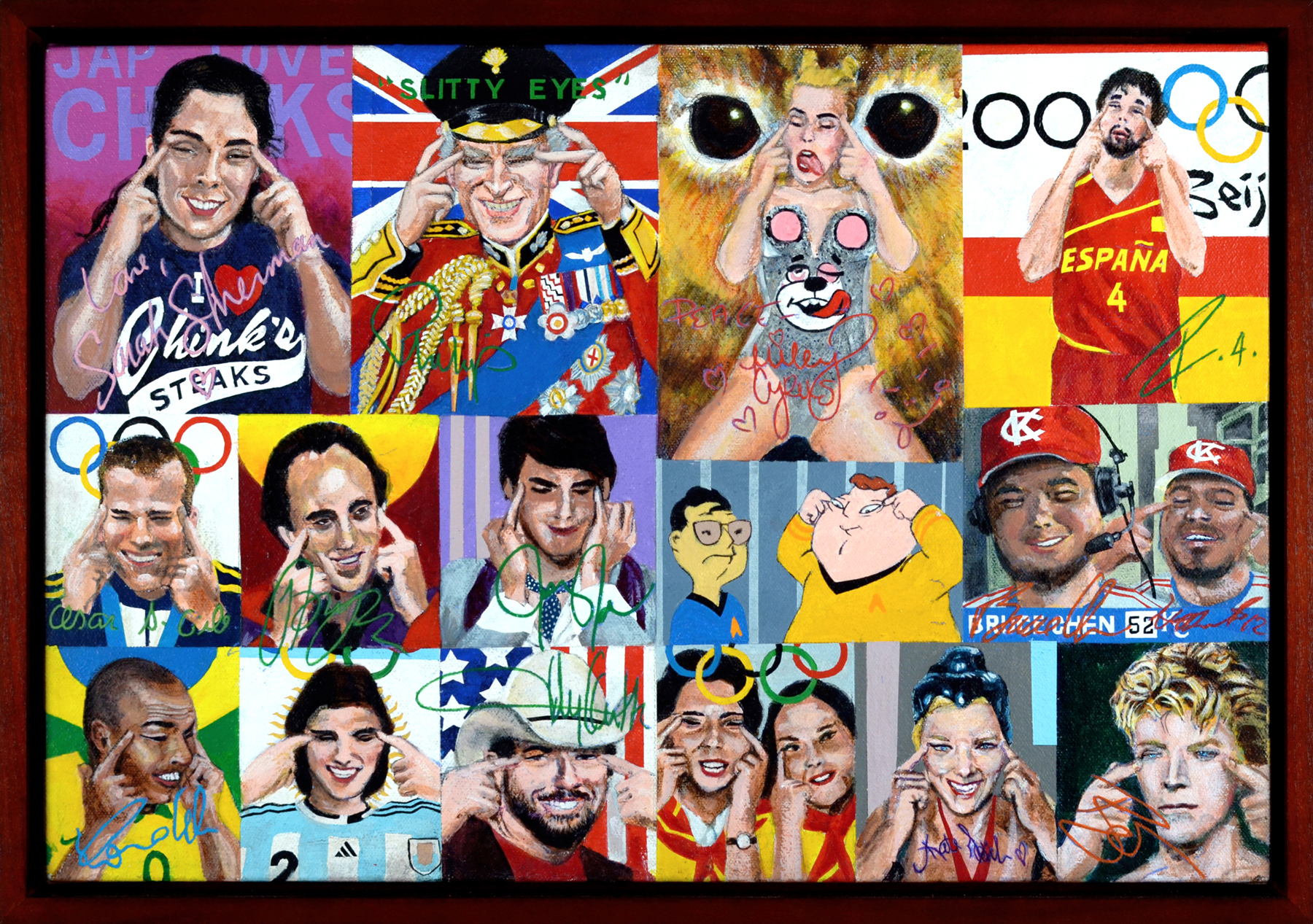
Ben Sakoguchi, Chinatown (detail), 2014. Acrylic on canvas; 15 panels, 11 × 16 in. each, 53 × 91 in. overall. Courtesy of the artist and Bel Ami, Los Angeles. Photos: Paul Salveson.
Union Station now occupies the place where this atrocity happened. A central local and regional transportation hub, the station was recently restored to its Mission Moderne grandeur. (Another echo, this one reverberates in the aesthetic preferences of long-ago settler colonialists, whose campaign to dispossess Kizh and Tongva people of their quotidian and spiritual connections to one of their most sacred sites has resulted in this ostensibly beautiful yet morally fetid tomb in the guise of a train station.)
Most of the fourteen smaller panels that radiate around Chinatown’s central panel explore an aspect of the historic and ongoing legal, political, visual, and filmic denigration of Chinese immigrants and those with Chinese ancestry in the United States. Some of the images Sakoguchi paints are appropriations of the nineteenth-century “yellow peril” propaganda used to gin up support for the Chinese Exclusion Act of 1882, and similar measures barring Chinese (and other Asian immigrants) from coming to the United States. In one panel, the artist appropriates an advertisement for a brand of rat poison, nastily illustrated with a racist caricature of a Chinese person eating one of the pesky rodents. In another panel, a Chinese worker is imagined as a manic, many-armed creature, busily assembling American flags and cigars while sending his earnings back to China. Like de Certeau, Sakoguchi quotes his (visual) sources at length, providing one pointed example after another—making his case via the aggregation of incidents and precedents.
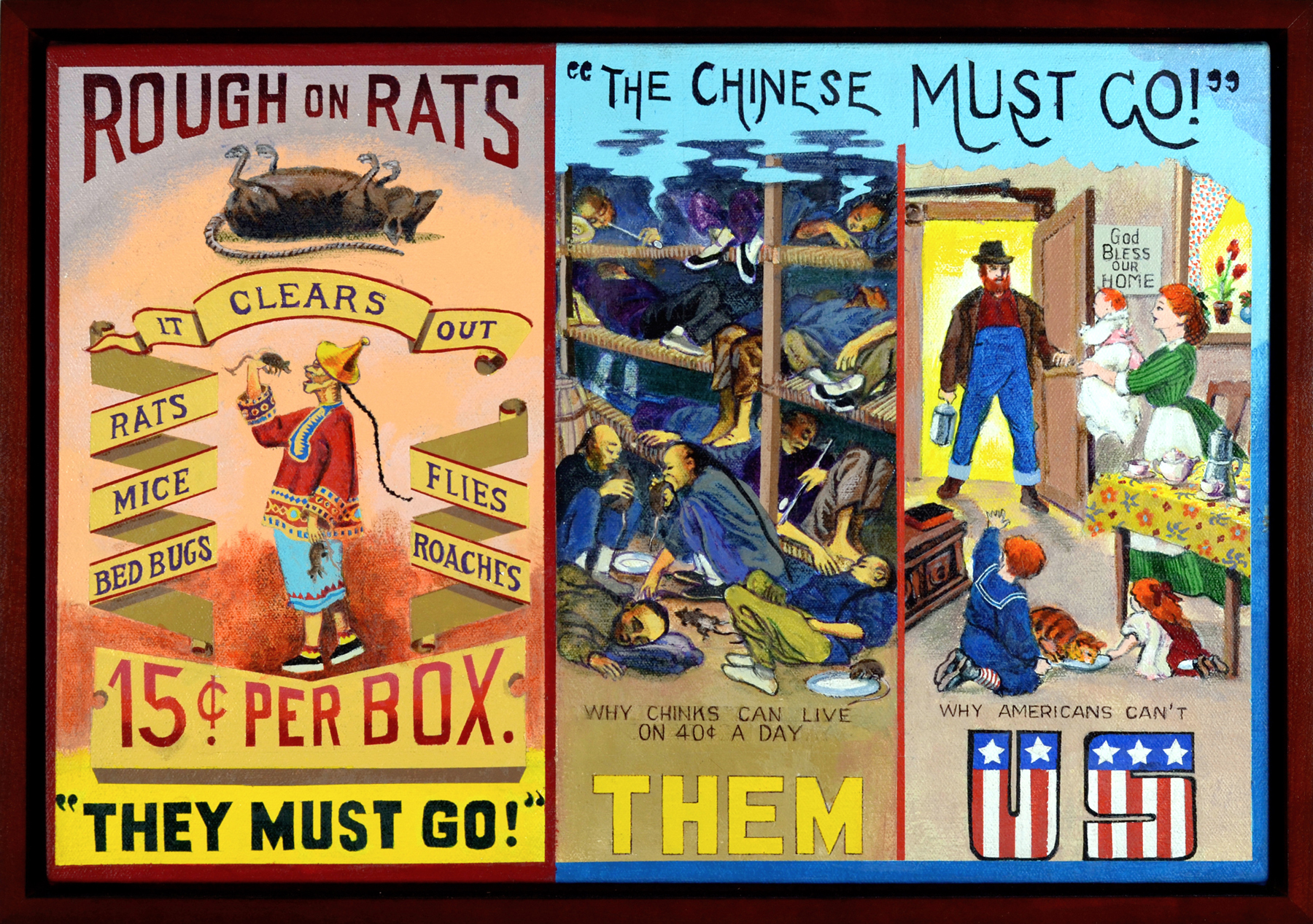
Ben Sakoguchi, Chinatown (detail), 2014. Acrylic on canvas; 15 panels, 11 × 16 in. each, 53 × 91 in. overall. Courtesy of the artist and Bel Ami, Los Angeles. Photos: Paul Salveson.
Sakoguchi’s analysis is not only leveled in terms of visual culture; sometimes he homes in on particular stories. He dedicates one panel to the story of Vincent Chin, who was beaten to death in 1982 by two white auto workers, one of whom shouted, “It’s because of you little motherfuckers that we’re out of work,” revealing his misapprehension of Chin as a Japanese national. Chin’s murderers were convicted but ultimately only given probation and a nominal fine of a few thousand dollars. Alongside Chin’s visage and a basic textual recounting of these events, Sakoguchi paints another of his jokes: “Q: What’s a Chinaman’s life worth in Detroit? A: Less than a cheap ’82 Japanese compact car.” The artist’s deployment of caustic humor is integral to his method, and I am thinking again of the mass murders at massage businesses in the Atlanta area: Already the FBI Director Christopher Wray has said that it “does not appear that the motive [of the shooter] was racially motivated.” 9
Already it has been chalked up to the shooter having a “bad day.” 10Already people have forgotten. Already more mass executions . . . Against this gradual winnowing of facts, the hedging of empathy, and the egregious excuse-making of those who want to minimize the reality of enduring anti-Asian sentiment and violence in the U.S., Sakoguchi gives no quarter. Ana Iwataki, in an essay written for the show’s catalog, adroitly describes Sakoguchi’s “painstaking collection and reproduction of images of Asians as they circulate through dominant visual culture,” noting that they seem to be “inflected with a lifetime’s worth of being pissed off.”11
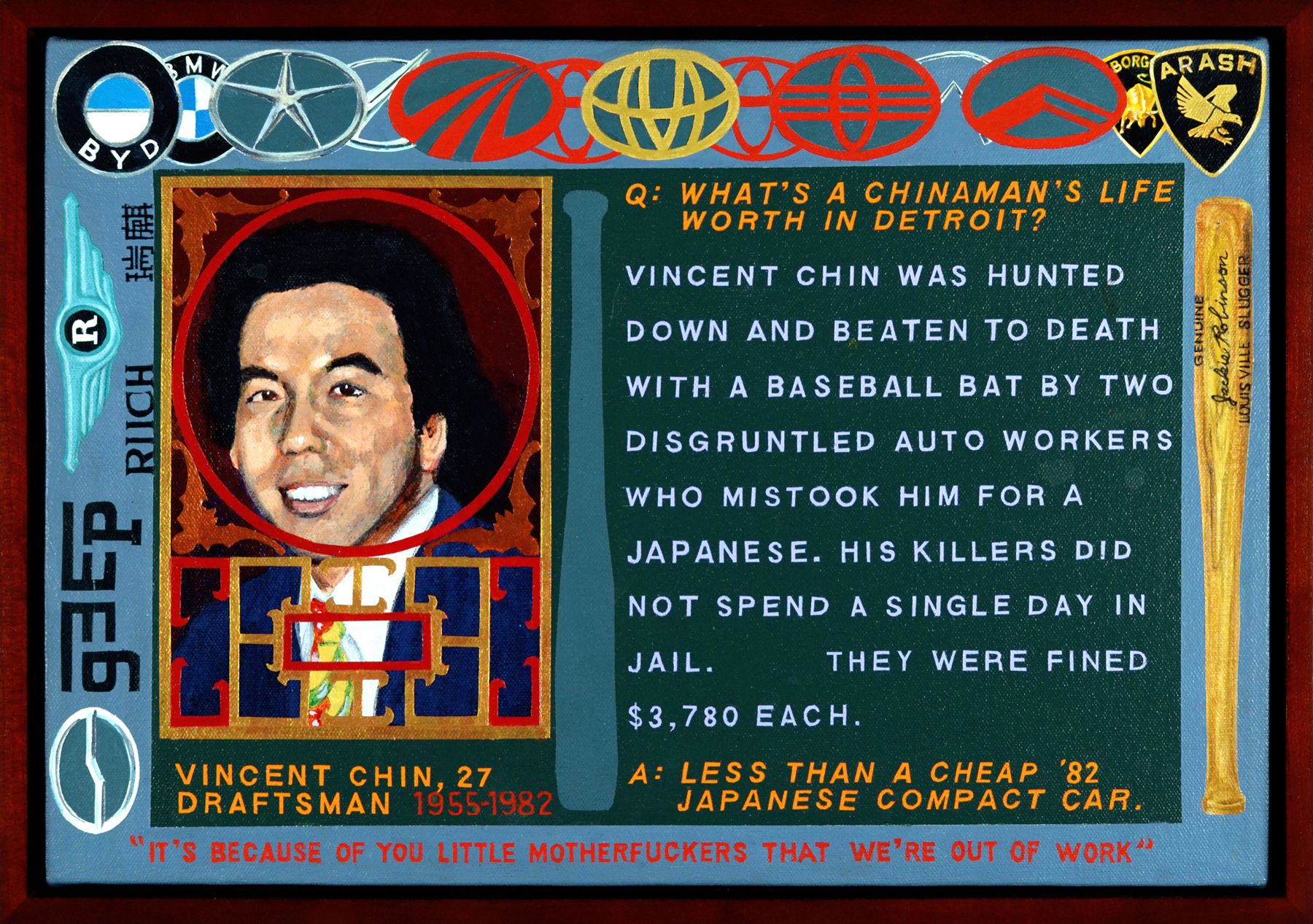
Ben Sakoguchi, Chinatown (detail), 2014. Acrylic on canvas; 15 panels, 11 × 16 in. each, 53 × 91 in. overall. Courtesy of the artist and Bel Ami, Los Angeles. Photos: Paul Salveson.
While typing out the descriptions above, I, too, feel the heat rising in my cheeks, water cresting my lower eyelids, hair standing on end. I am continually coming to terms with the complicity required to retell these stories as an art critic, attempting to do justice to their deep and wounding effects. I imagine you might go through something similar when reading my descriptions here, but I’m not sure. It seems unavoidable that all this recounting of Chin’s death, which cements the most awful fact of his life as the first and most important thing to know about him, sustains his inhumanity. Other details must then be repeated before they fade and disappear, leaving Chin to be merely an illustration of—an example of—the violence against him, rather than a fully formed person. I might mention, for instance, that Chin was engaged to be married a little more than a week after his murder, cementing for me not some normative path to respectability, but an acute sense that he was loved, and loving, too. Or the full and embodied reality of his daily grind, working weekends at a Chinese restaurant called Golden Star on top of his nine-to-five job as an engineer. Maybe when we think of Vincent Chin we should feel that—the striving toward love, the exhaustion of trying to meet it—in our bones. Call it the continuing impossibility of America, its punishing becoming.
Indeed, this is where all historical endeavors—including Sakoguchi’s paintings—fall short. Even when all we have left is a collection of biographical data, the wrongness of Chin’s death (represented by an image of him), it is simply not enough. Visual representations may be one of the most potent ways of attending to the dead, but they are not public policy. They are not, by themselves, responsible for large-scale cultural shifts, but what they can do is aid in imagining, or stabilizing, or reflecting upon an ostensibly shared ground of values—in this case a support for human life and autonomy. Shared images, like the ones Sakoguchi studiously repaints (whether vile or admirable), undoubtedly participate in helping some people to imagine how they might live or organize themselves otherwise.
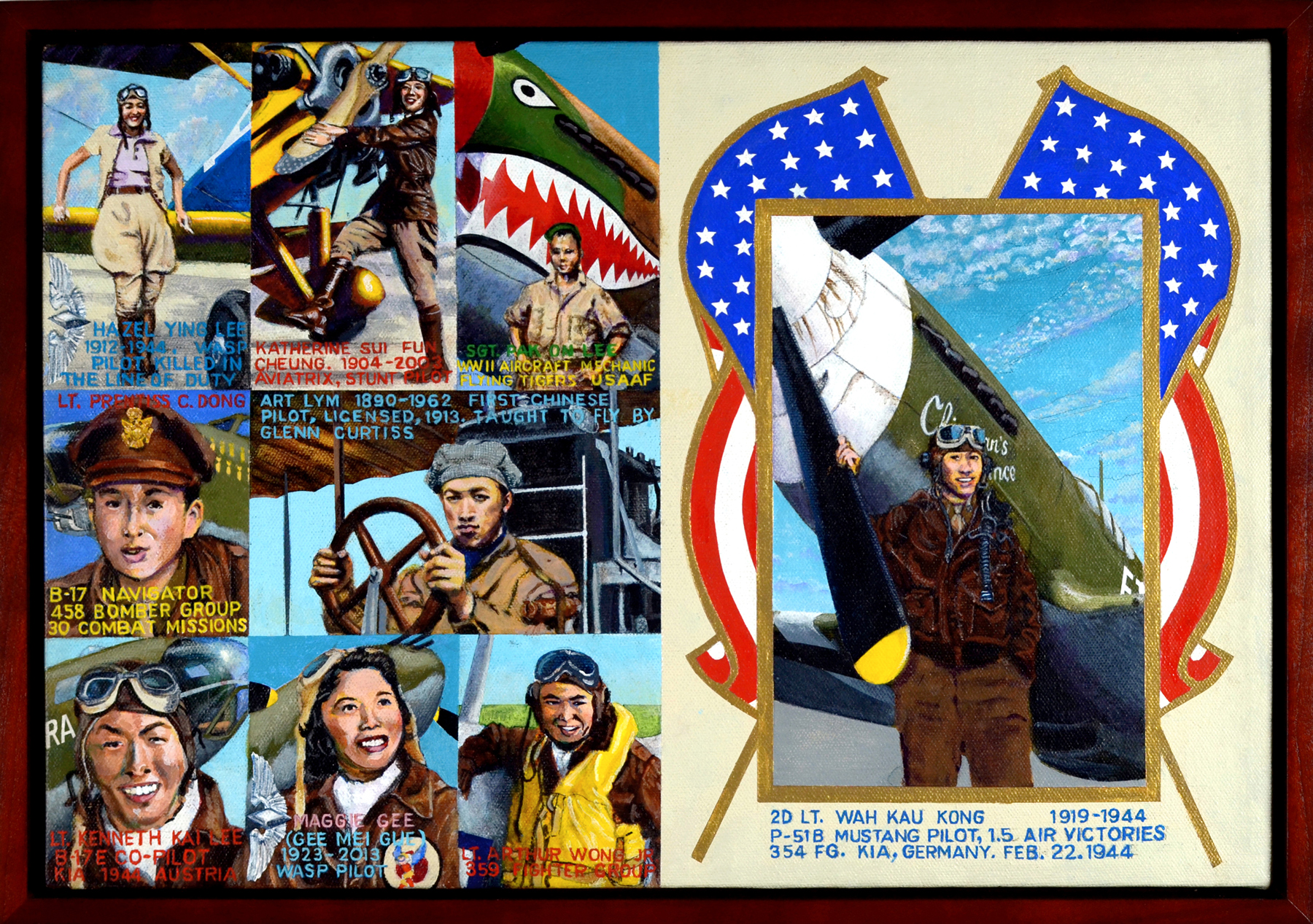
Ben Sakoguchi, Chinatown (detail), 2014. Acrylic on canvas; 15 panels, 11 × 16 in. each, 53 × 91 in. overall. Courtesy of the artist and Bel Ami, Los Angeles. Photos: Paul Salveson.
While Sakoguchi is a fiercely astute observer of the forms of anti-Asian racism in the United States (and other paintings of his address the histories of slavery and baseball’s Negro leagues and anti-Black racism), he is also ever-optimistic, highlighting specific stories of achievement to counter the violence that stereotypical representations instantiate and reiterate. In Chinatown, two panels in particular lift up the achievements of eighteen Chinese American men and women (a precise numerical ballast to the hanged bodies in the central panel) who served in the United States Armed Forces from the Civil War onwards. Through this lens of patriotism, Sakoguchi calls attention to people such as Katherine Sui Fun Cheung, described as the first Asian American aviatrix.12 Cheung was a flight instructor in the United States during WWII, and, before that, a celebrated stunt pilot. (The actress Anna May Wong and other members of her Chinese American community pitched in the requisite funds to help buy her a biplane.) Once she quit flying, she spent the rest of her life operating a flower shop near where she lived in Los Angeles’ Chinatown, not far from where Bel Ami is now located.
Set against the other panels detailing systemic anti-Chinese and broader anti-Asian sentiment and violence, the military service of these extraordinary women and men becomes a lonely and narrow path toward respectability. Is it the only route? Is this the prerequisite for humanity? For retaining bodily and psychic autonomy?
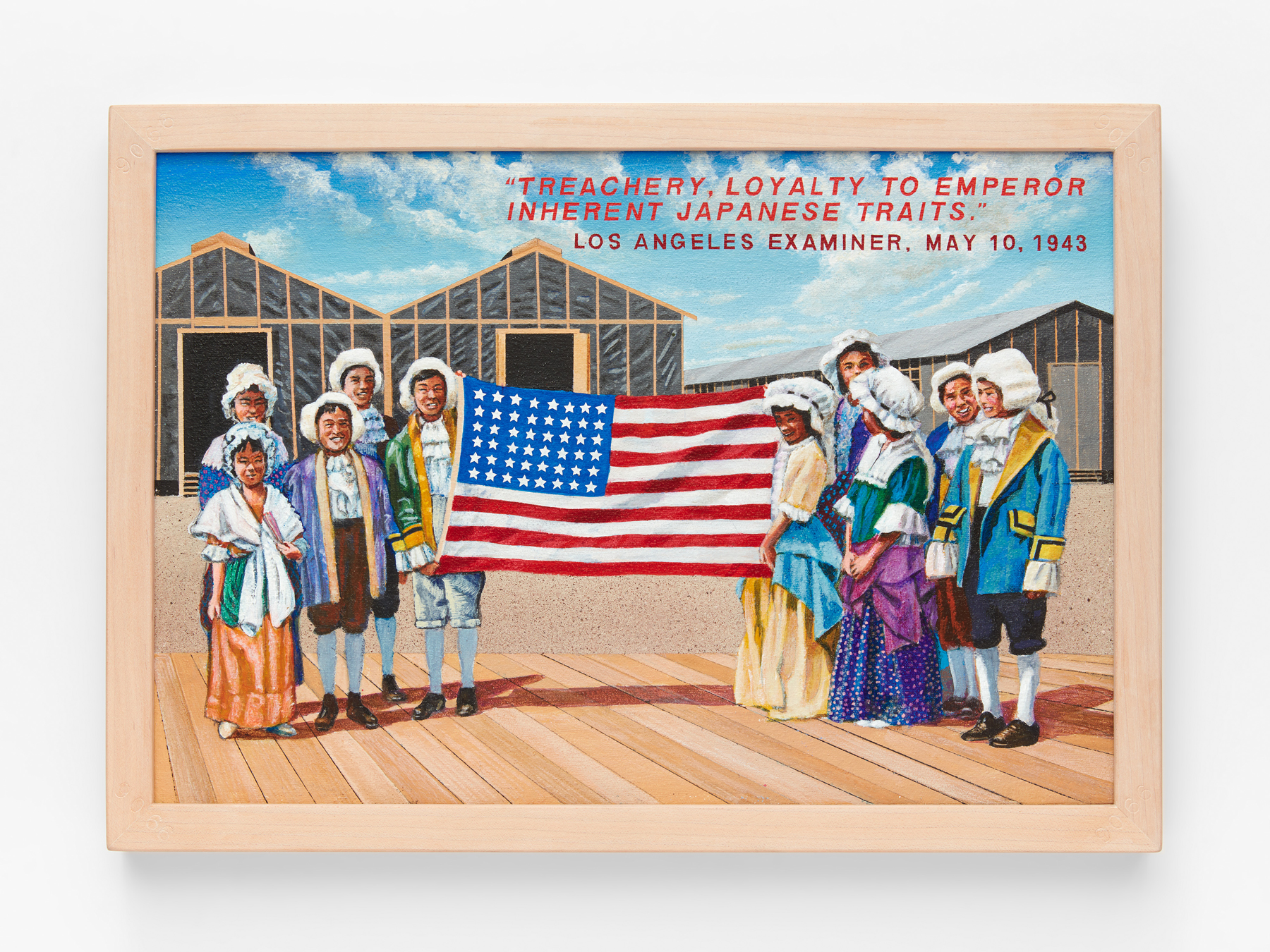
Ben Sakoguchi, Postcards from Camp (detail), 1999–2001. Acrylic on canvas; 40 panels, 11 × 16 in. each, 52 × 204 in. overall. Courtesy of the artist and Bel Ami, Los Angeles.
Thinking about how to answer these questions, I recall one of Sakoguchi’s works reflecting his earliest memories as a child incarcerated with his family in Poston, Arizona. The site was one of many US concentration camps in operation from 1942 to 1945 and was constructed to hold Japanese Americans in indefinite detention. One of the forty panels of Sakoguchi’s Postcards from Camp (1991–2001) displays a group of young children standing on a simple platform made of two-by-fours. Behind this makeshift stage, large, long buildings with unfinished exterior walls compose the child actors’ real-life backdrop. They are putting on what looks to be an Independence Day play; the boys are wearing white powdered wigs, and the girls modest bonnets. Together they hold up an American flag and smile. It is a perverse image, incarcerated kids glorifying the motivating values of their jailers. But they are just kids, after all. And as if to underline a viewer’s sense of horror,
Sakoguchi has taken a few words from a 1943 Los Angeles newspaper and painted them floating in the blue sky above their patriotic play, “Treachery, Loyalty to Emperor Inherent Japanese Traits.” This cognitive dissonance between image and text, a common tactic Sakoguchi employs, reveals a value system rotten from the inside out—a selective inheritance of “Americanness” spread and applied unevenly across geography, time, and ancestry.
In the week between my first and second visits to see Sakoguchi’s show, I read Charles Yu’s 2020 novel Interior Chinatown. Yu’s novel describes the world as a television show—where Asian men and women are typecast in a never-ending police procedural called BLACK AND WHITE, which is focused on two detectives (one black, one white; one male, one female). Key scenes of this fictional show are set in the Golden Palace Restaurant, a crime-ridden site of intrigue and death on the ground floor of a single-room-occupancy tower in an unspecified Chinatown. Yu’s setting is an amalgam of historical Chinatowns in the United States, and he lets a reader know that his fiction tracks with reality by including epigraphs from Bonnie Tsui’s American Chinatown: A People’s History of Five Neighborhoods (which examines the history and development of the Chinatowns in New York, San Francisco, Los Angeles, Honolulu, and Las Vegas), Philip Choy’s San Francisco Chinatown, and Erving Goffman’s The Presentation of Self in Everyday Life.13 (This last text is described in Yu’s acknowledgements as one that he will “keep rereading until I can’t read anymore.”) 14
Interior Chinatown is written in the form of a screenplay with lengthy, pleasurable asides from the novel’s primary protagonist (more about him in a bit). This means that, as per the formal conventions of a teleplay, all of the inhabitants of Yu’s fictional yet knowingly familiar milieu are named in all caps every time they speak or act. The result is the unremitting repetition of a motley yet homogenous array of stereotypical roles: OLDER BROTHER, RESTAURANT HOSTESS, OLD ASIAN MAN. Movement exists between some of these assignations, but it is often limited to a dyadic toggle and not a dynamic lived existence within a spectrum of possibility: YOUNG DRAGON LADY too easily becomes OLD ASIAN WOMAN, and BEAUTIFUL MAIDEN NUMBER ONE is really just the prior state of DEAD BEAUTIFUL MAIDEN NUMBER ONE. Young—Old; Alive—Dead.
Yu’s protagonist has a particularly noteworthy journey. He begins his life as KUNG FU KID with dreams of grandeur: to one day become KUNG FU GUY—the very tip-top in the hierarchy of televisual/filmic Asian male representation. To his disappointment, he finds himself cast as GENERIC ASIAN MAN and, eventually, ETHNIC RECURRING, sometimes with the added bonus of a few lines spoken in English with a conspicuous accent. But he is more often cast in non-speaking background roles, serving as a form of noirish human décor, not dissimilar to the notion of ornamental personhood described by theorist Anne Anlin Cheng as “the life of a subject who lives as an object.”15 Eventually, Yu’s protagonist realizes his ambition to become KUNG FU GUY, but by the time this happens any sense of victory is undercut by the relationships he sacrificed in pursuit of his aspiration. In the book’s stunning final third, he transmogrifies into KUNG FU DAD. Then, only after understanding the magnitude of the history of oppression that binds him to the limited number of roles he has hitherto inhabited, does the one-time KUNG FU KID finally become simply, and radically, YOU.
To get here—from KUNG FU KID to YOU—Yu must go through the same obstacle course of inconvenient history that Sakoguchi sketches out in Chinatown, including more than a century and a half of anti-Chinese legal restriction and scapegoating, all of which was the result of broader cultural and social hostilities directed toward Asian Americans. In two short sections of the book that are formatted as court-submitted evidence (“Exhibit A” and “Exhibit B”), Yu gives an accounting of the changing outlines of anti-Asian policy in the United States by listing a number of constitutional amendments and governmental policies, enacted over the course of the nineteenth and twentieth centuries, regulating immigration, interracial marriage, and property ownership. Why return to this litany of historical atrocity? Why do the bodies need to be stacked and counted to matter? In the aftermath of incidents of violence against Asian and Asian American people during the COVID-19 pandemic, many writers have offered their own vile listicles of historical animosities ossified through law and common (white) sense. These lists are all a little different, but their force is the same—to prove, in no uncertain terms, that racist violence directed at Asian and Asian American people is the rule rather than the exception in US history. Yu’s list ends with the Immigration and Nationality Act of 1965 (also known as the Hart-Celler Act), which abolished the quota-based immigration formula at the heart of early twentieth-century immigration policy in the United States, and this seems to suggest that, despite the sick sense that we’ve been here before many times, progress is possible. But such lists implicitly and explicitly argue that it won’t be possible to get to that next place, to YOU—reversing the ornamentalism that Cheng describes—without acknowledging, internalizing, and working to rectify these multigenerational traumas.
Before returning to the Bel Ami gallery for my third and final visit to Chinatown, I fell down the rabbit hole of Sakoguchi’s website.16 And happily so.
Sakoguchi populates his website with a comprehensive overview of a career that has sustained an experimental, socially conscious energy. It is worth doing some looking here. You might find The Empress-Dowager’s Marble Boat (1989), a wry send-up in the form of the Boat of Purity and Ease (a pleasure pavilion in the shape of a stone boat on the grounds of Beijing’s Summer Palace), wherein Sakoguchi deploys communist kitsch to comment upon the Tiananmen Square student-led uprising and subsequent massacre in 1989. Or Remember Me: AIDS (1991–92), a dense copse of free-standing and wall-mounted painted tombstones giving honor to dozens (of the millions) of people who lived with HIV and who perished in the first decade of that earlier, still ongoing, pandemic. Sakoguchi presents an accumulation of photos and ephemera related to those he memorializes—artist Keith Haring, activist Belinda Mason, and fashion designer Willi Smith, to name a few—at the base of each form, turning them into physical manifestations of a polyvocal, collective expression of mourning. These works warrant being considered anew.
As a COVID-19 coping mechanism, I had already been following Sakoguchi’s website for monthly updates of paintings he completed under quarantine, in which he processed the unfolding events of the United States under lockdown: the rising death-count (100,000, 200,000, 300,000, 400,000, 500,000 . . . ), the racial justice protests in the wake of the death of George Floyd (and Breonna Taylor, and Ahmaud Arbery, . . . ), the open animus expressed by antivaxxers and anti-maskers toward public health measures and restrictions tied to shifting scientific response. Sakoguchi’s satirical and unsparing paintings have surfaced the cruelty, lies, and anxieties of this past year for me in a way that few other works of art have been able to.
But much of my time on Sakoguchi’s website has been spent in the sections titled Meadowbrook Albums, and Mary’s Cash Grocery, where the artist has corralled clippings, photographs, and stories about the San Bernardino neighborhood he grew up in and the small grocery business his family owned in the years before and after their incarceration in Poston. These pages present historical media coverage and documentation, helpfully annotated and underlined, in a sometimes near-endless vertical scroll. These archival documents disclose a great deal about the inner workings of a twentieth-century Japanese American family and their neighbors in Riverside County. Sakoguchi attends to the various families in the area and their long-time addresses, giving each its own page—217 E Third Street / Contreras, for example. He also assembles separate pages for recurring events (The National Orange Show and The Pittsburgh Pirates’ Spring Training Camp), institutions (Meadowbrook School and Recreation Center), and persons of note (Joe Fisher, ‘Police Character,’ and Frances Ridste – Hollywood Starlet). In short, he makes visible the stories of a neighborhood— an assemblage of the personalities, triumphs, and tragedies that make life worth living. Clicking through the nearly one hundred pages that comprise these two sections of Sakoguchi’s website is similar to reading The Possession at Loudun, as one is left to piece together the sundry events, effects, social circles, scandals, and family histories into a coherent, diachronic history.
Perceptive visitors to these pages on Sakoguchi’s website will be rewarded for their persistence. After a few hours of concerted looking, I came across a photograph of the artist as a young toddler waddling out to the corner of Allen and King streets, where his family’s grocery was located, while a neighbor bends down nearby to address him. Days later I encountered a photograph of an older (but still young) Sakoguchi painting a mural dedicated to the subject of sports at San Bernardino Valley College. Looking at the photograph, the artist seems balanced and jovial, working atop a ladder while two of his peers converse below in what appears to be a staged-to-look candid photograph.
Alongside the scroll of photographs, census records, articles, and documents, Sakoguchi sometimes includes one of his own paintings, as if it were simply another bit of information, more evidence of life’s happening. Many of the paintings Sakoguchi includes in the Mary’s Cash Grocery section are culled from the artist’s Postcards from Camp series, indicating how central the camp experience was in the overarching narrative of the family business, and, conversely, how central the business was to Sakoguchi’s retelling of his family’s incarceration. The paintings inserted into the Meadowbrook pages are pulled from across his broader oeuvre.
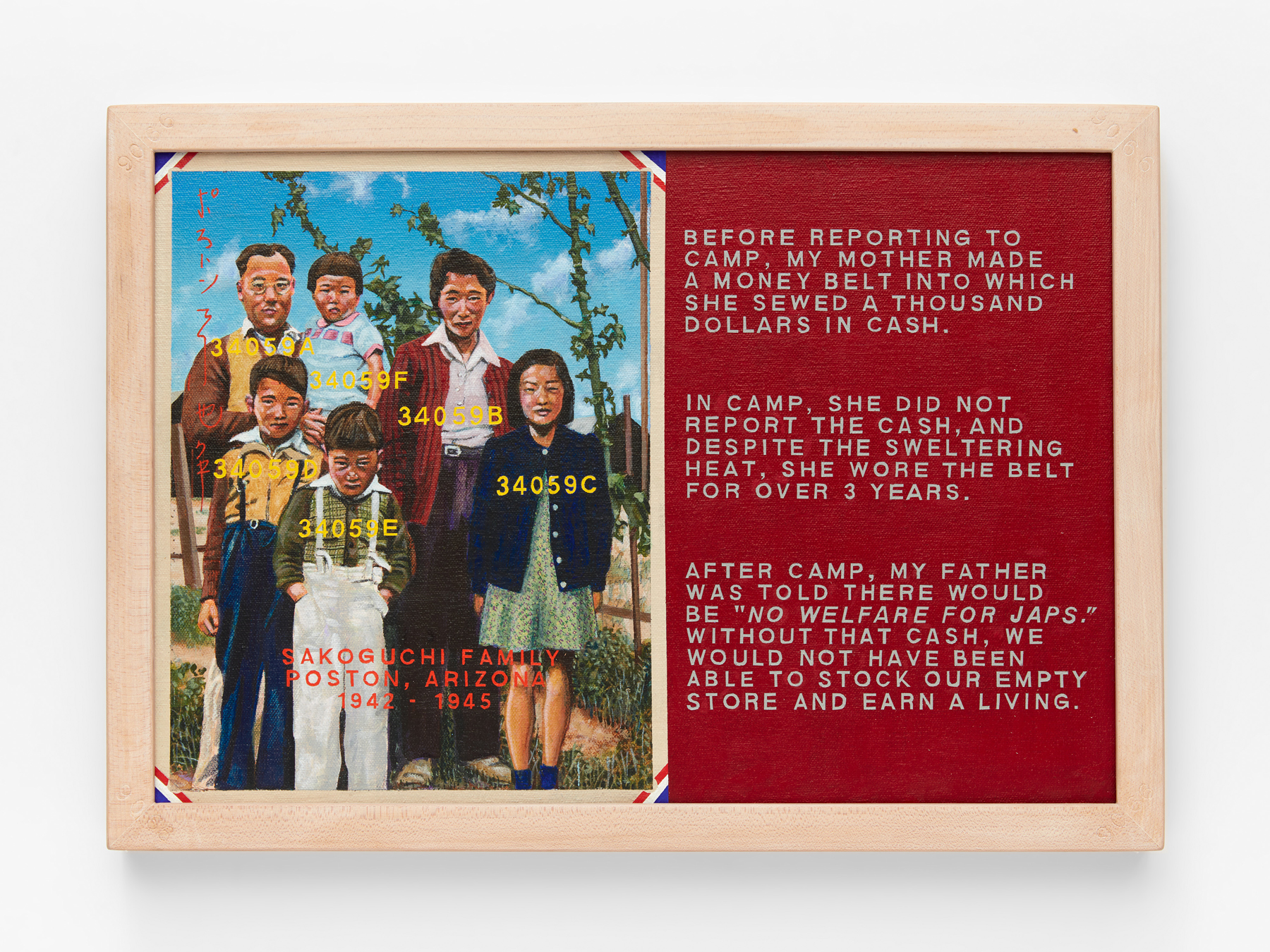
Ben Sakoguchi, Postcards from Camp (detail), 1999–2001. Acrylic on canvas; 40 panels, 11 × 16 in. each, 52 × 204 in. overall. Courtesy of the artist and Bel Ami, Los Angeles.
One of the paintings that Sakoguchi deploys to tell the story of Mary’s Cash Grocery depicts a color photograph of the Sakoguchis gathered for a family portrait in what appears to be a patch of garden. Bright yellow identification numbers float at chest height over each Sakoguchi, marking the six members of this nuclear family as related via the ascending letters affixed to a common five-digit integer—34059A, 34059B, 34059C, 34059D, 34059E, and 34059F. Running down the left side is a line of red Japanese text. Here I make out “Poston,” in calligraphic katakana, but the rest I (woefully) cannot read. Three lines of orange text, this time in English, further identify the subjects: “Sakoguchi Family / Poston, Arizona / 1942–1945.” To the right of this painted photograph is a short narrative. It reads as follows: “Before reporting to camp, my mother made a money belt into which she sewed a thousand dollars in cash. In camp, she did not report the cash, and despite the sweltering heat, she wore the belt for over 3 years. After camp, my father was told there would be ‘no welfare for Japs.’ Without that cash, we would not have been able to stock our empty store and earn a living.”
Taking the form of a linear progression tracing the before, during, and after of incarceration, Sakoguchi’s written recollection includes a detail—the hidden money belt—we cannot see, something identification numbers and US bureaucracy couldn’t adequately account for. This act of foresight and resistance on his mother’s part is likely what enabled the Sakoguchi family to return to their former home and business once the war was over.
“History is never sure,” writes Michel de Certeau, reflecting on the impossibility of honing any historical account to a finite point.17 Scanning Chinatown, I recognize its collected history of Asian achievement and anti-Asian violence as the kind of historiographical exorcism de Certeau promotes. But unlike the priests and doctors in de Certeau’s account, Sakoguchi’s questions are not “What is it?” or “Who is there?” We know these devils lurking under the fascia of political probity; they are us. Instead, Ben Sakoguchi points and asks, again and again: Where must we go from here?
How must we do the work? Compromised discourse. A terrible game. Once grasped, the manifold answers to these questions might signal a new drama of a perturbation in knowledge—or simply reveal yet another facet of an ever-persistent echo.
(a wish)
(a command)
OUT!!!
Andy Campbell is an art historian, critic, and curator working in Los Angeles and living in Long Beach. He is an Associate Professor of Critical Studies at the Roski School of Art and Design, University of Southern California.
